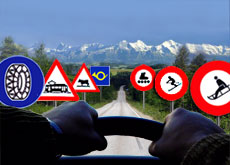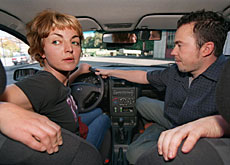Driving towards success in Switzerland

Switzerland's reputation for thoroughness also extends to the driving licence, as a swissinfo journalist finds out.
But having battled her way through strange reversing manoeuvres and lots of new theory, Isobel Leybold-Johnson thinks the Swiss way may not be so bad after all.
After failing my test in Britain as a student, I arrived in Switzerland thinking it was high time to start driving again.
The first step was to get a provisional licence – you have to be 18-years-old – and to buy a nice blue “L” plate, as learners are not obliged to train with an instructor.
I also obtained a thick copy of the Swiss Highway Code and a book of test questions for the theory exam.
So far so good. However, it was then that I realised that the Swiss driving licence was going to take a lot longer than I thought.
Four stages
There are four stages to get through. Apart from the theory and practical test – which I was already used to from Britain – there was also first aid and the highly mysterious Verkehrskunde.
The first aid course was my first experience of Swiss thoroughness – eight lessons of 75 minutes – but also very useful.
Next up was Verkehrskunde. Roughly translated as “traffic awareness”, the eight-hour course was devoted to explaining the finer points of driving, including tactics and how to behave towards other road users.
It also covered not drinking and driving and – particularly relevant to many a young Swiss – not smoking cannabis and driving…
My driving instructor, Jürg Schneider, who has more than 30 years’ experience, explained that the relatively new Verkehrskunde course was set up for safety reasons.
“It was introduced so that learner drivers don’t first have to have negative experiences when driving but already have theoretical knowledge of the dangers on the roads,” he told swissinfo.
Theory challenge
The next big challenge was the computer-based theory test, which I opted to take in English – the only foreign language permitted.
The theory turned up some interesting differences to Britain. What immediately struck me were the signs that you could only find in a mountainous and snowy land: Skiing prohibited! No tobogganing!
A yellow horn in a blue sign meant that drivers should obey the instructions given by the Post Bus, the yellow vehicle which miraculously manages to make its way along the country’s narrow and twisting mountain roads.
Having safely negotiated the theory, I moved on the practical lessons, which I did in combination with practising on my own.
Thoroughness
This is where I really appreciated Swiss thoroughness. What I found good was that we went on the motorway quite early on. In Britain this does not even form part of the training.
What was a bit baffling, however, was the reversing manoeuvre. This first involved changing to the left side of the road from the usual right. Then you had to – somewhat alarmingly – reverse around a corner while facing the oncoming traffic (the idea being not to hinder traffic flow).
This was all a bit different from simply reversing round the corner on the same side of the road, as in Britain.
Schneider agrees that this is a “special Swiss manoeuvre”, but he says that it has its usefulness.
“Other countries don’t have this and there has already been a discussion about stopping it, but on the other hand, it’s the only way that teachers are forced to practise reverse driving with their pupils,” he said.
And so onto the test, which I am pleased to say I passed first time! However, rather frighteningly the rules are such that if you fail four tests in Switzerland then you have to take a psychological test before you are allowed to do another one.
Not so bad
But Schneider says this is not as bad as it seems, at least in canton Bern.
“Now you go to the head of the traffic department, he is a trained psychologist, and he speaks to you and your teacher about why it hasn’t worked, such as not enough practice, particular test fears, and then normally he does the next test himself,” he explained.
So what it my overall assessment of the process? Well, it certainly is expensive, costing an average of SFr2,500 ($1,889) for all four parts, including an average of 20 lessons and administrative fees for tests and licences.
But I have certainly been well trained and know how to handle both normal roads and motorways.
As to whether this lengthy process makes us all good drivers – you’ll just have to judge for yourself.
swissinfo, Isobel Leybold-Johnson
It has been estimated that the four-part driving licence costs at least SFr2,500.
It normally takes around 3-6 months to complete. On average between 20-40 practical lessons are needed.
Practical lessons cost SFr80-90, with the test costing SFr132 and the driving licence SFr60.
The Swiss system is said to be one of the most expensive in Europe.
The Swiss driving licence consists of four parts – the practical and theory tests, as well as first aid and a “traffic awareness” course.
From December 1 new drivers will receive a temporary driving licence valid for three years.
They have to take two further driving courses and commit no traffic offences during this time to get the full licence.

In compliance with the JTI standards
More: SWI swissinfo.ch certified by the Journalism Trust Initiative


You can find an overview of ongoing debates with our journalists here. Please join us!
If you want to start a conversation about a topic raised in this article or want to report factual errors, email us at english@swissinfo.ch.